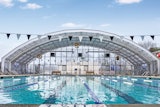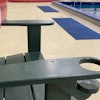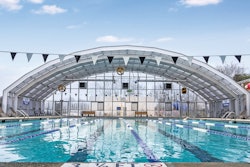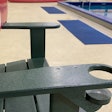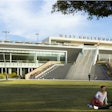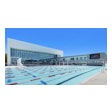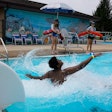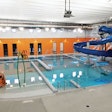A survey of your pool facility can highlight damage you can't see and help fix it cost-effectively.
It's not tough to spot problems in aging pool facilities - tiles missing from the deck, a suspended ceiling that sags, rust around door frames, high humidity. The solutions to these problems may seem just as apparent: replace the tiles, install a new ceiling, paint the door frames, upgrade the HVAC. Unfortunately, this approach may overlook more serious and costly issues that aren't visible but are even more important than the ones being addressed. A repair that appears to be the most logical and cost-effective solution may in fact end up being the most expensive one, because correcting the real problem can cost more money later.
A better strategy is to conduct a thorough facility assessment of the mechanical, electrical and structural systems in the building, and of the filtration, circulation, and chemical treatment systems for the pool. This will uncover problems that aren't apparent, suggest cost-effective solutions and become the basis for deciding what to repair, what to replace and the timetable in which to do it. Safety considerations and code issues also are addressed, and potential payback is calculated so benefits can be compared with costs.
These kinds of studies are ideal for pool facilities, where water, humidity and chemicals create a harsh, corrosive environment. Pools more than a decade old are particularly vulnerable to problems, because earlier systems were more susceptible to corrosion.
A comprehensive facility survey - which should be completed every 10 years or so - typically is conducted by a team of architects, engineers and pool design specialists who usually incorporate all systems into their approach. While vendors may know their own systems and equipment well, the cause-and-effect nature of systems often requires the broader knowledge that this committee approach can offer.
The specific components examined in a survey will depend on the individual pool and facility. But understanding the more important problems that may be uncovered in each of the major systems of a building and pool, as well as how to correct them, can provide facility owners with a sense of what to expect.
Building Systems
• Mechanical system. If standing at the edge of an indoor pool in street clothes feels uncomfortable, it's a good bet there are humidity problems in the building. That's an indication that the heating, ventilating and air conditioning system is not handling the moist air that comes from the pool properly. Humid air creates problems in any type of building, but with the chemicals used to purify pool water also present, the damage can be extensive. Anything the air comes in contact with - pipes, ducts, heating coils, even steel building supports - can become corroded.
While it might seem that replacing a corroded pipe or duct would be enough, the problem will recur if the damage is being caused by faulty ventilation - unless the solution addresses the root of the problem. In a facility survey, mechanical engineers can ascertain whether the flow of air and the humidity levels (or something else) are causing the damage and can offer suggestions on how to correct it.
Correction may involve replacement and redesign of the entire system or individual components, and it also may be necessary to establish lower air pressure in the pool area than in adjoining areas to keep contaminated air from dispersing to other parts of the building. One way to do this is to exhaust more air from the pool area than is supplied to it. Exhausting air keeps the pressure in the area lower than that in adjoining areas; uncontaminated air from adjoining areas then tends to move into the pool area and less pool air moves to adjacent spaces. This minimizes the chance that corrosion to other building areas will spread.
• Structural system. Structural problems, which are among the hardest to identify, can cause the most serious safety issues. The appearance of concrete, for example, can be deceiving. It may look sound but actually be so saturated with chlorine that it could disintegrate under stress. Furthermore, the symptom of a critical problem may be as innocuous as a broken or cracked tile - especially in older pools that either were built with tunnels under the decks for easy access to piping or have air ducts alongside the pool walls. While the design makes maintenance easier and provides a space-saving area for ductwork, it also invites more opportunities for structural damage.
Even if a pool does not have tunnels, ducts or other open areas along its sides, damage can be substantial. At one community pool, broken and cracked tiles and inadequate drainage on a deck convinced an assessment team to drill core samples of the concrete and test them. The team discovered that chlorinated water not only had seeped into the structural concrete slab below the deck, but also had deteriorated the steel rebar inside the concrete, compromising its strength. Had the most obvious solution to the problem been carried out - installing new tiles - the situation would have worsened, possibly resulting in a sudden collapse of the deck.
The steel structure or supporting elements of a pool facility's roof and ceiling can be damaged by contaminated air. Like damage to concrete, damage to structural supports can cause catastrophic results, as it did when one community pool's roof collapsed. The cause was found to be an inadequate ventilation system, which over the course of several years kept warm, chlorine-laden air drifting toward the ceiling, leading to corrosion. If a pool facility has a suspended ceiling, damage to structural elements may not be easy to see. But, again, the problem would be obvious to a full survey team that includes structural engineers.
• Electrical system. Like any other building system, the electrical system can be affected by a corrosive environment. A facility survey checks power panels, wiring, lighting, and paging and fire alarm systems. Rust on metal parts, which can cause electrical malfunctions and other safety problems, are investigated to determine the extent of problems caused by humidity and pool chemicals. Infrared thermal scans are used to pinpoint "hot spots" that indicate overheating at connection points - especially in circuit breakers, where corrosion could prevent the breaker from tripping when it should.
Lighting fixtures over the pool may not operate if there is significant corrosion. And if ceiling parts to which the fixtures are attached have been affected, those fixtures could fall. A survey suggests solutions to prevent future damage, and also determines whether lighting levels are adequate for the way the pool is used. Competitive swimming, for example, requires higher foot-candle levels than recreational use, according to recommendations by the Illuminating Engineering Society. The condition of emergency lighting systems also is included in the survey, as is an evaluation of how well a facility meets requirements of the National Fire Protection Association.
Pool Systems
• Pool structure. As with building structures, deciding what to do about pool problems - leaks and corrosion, for example - can better be addressed with information from an independent facility assessment. And much like structural problems that arise, the source of a leak may not be the most obvious one. In fact, the pool structure usually is not the cause of leaks; improperly functioning pipes, gutters or drains are the more likely culprits. If a study yields no defects in these components, then the pool structure is carefully evaluated. Again, corrosive characteristics of chemicals and water seeping into the concrete can cause devastating damage.
Aluminum and steel pools can suffer a different sort of damage not easily seen. The long-term contact between aluminum or steel, water and concrete at the deck's edge can cause an electrolytic reaction (much like a battery) that eats away at the pool. Sometimes it's more cost-effective to remove the damaged part and replace it. But repair isn't always possible if the chemical action is widespread.
When the finish on a pool shows signs of wear, repairing or replacing it may be warranted if damage to structural elements has been ruled out. An assessment can point the way to the most cost-effective finish surfaces - from ceramic and fiberglass pools to plastic liners and painted surfaces.
• Filtration system. In addition to identifying problems caused by corrosion, a complete pool facility assessment will look carefully at the filtration system. Pipes, valves, pumps, tanks and the filtration medium itself are potential problem areas. Pipes and tanks can leak and valves can fail, particularly in older systems where they can be corroded shut or open.
If the filtration medium is sand, a backwashing process cleans the filter. But backwashing too frequently causes channels to form, making the filtration process less efficient. The size of the sand particles also will affect the cleaning process. If they're too big, they allow too much debris to be recirculated; if they're too small, they slow down the process. The wrong size can also create problems with pump operations. Sand can be replaced and maintenance procedures changed, but the assessment may also point to an upgrade of the entire filtration system.
Filtration systems that use diatomaceous earth can handle smaller particles faster. Labor costs to maintain them, however, are greater, and replacing the diatomaceous earth and disposing of the waste material can be more costly than replacing sand.
A facility analysis addresses similar issues and cost assessments with cartridge filters.
• Circulation system. An assessment of a pool's circulation system involves checking the piping, gutter or skimmer, surge tank, return pipes in the pool walls and floors, and the main drain. Gutters and skimmers collect water displaced by users and send it to be filtered, so it is important that these components function properly.
Older systems may appear to be working, but they might not be absorbing displaced water and quelling waves as they should. This could allow dirty water to splash back into the pool instead of being sent for filtration. When that type of problem is discovered, it often is better to replace the system. An assessment also will determine whether the type of gutter is adequate for how the pool is being used. One type of gutter system, for example, tends to enhance the performance of competitive swimmers by an improved ability to quell waves.
Besides leaks, it is not uncommon for surge-tank valves in older pools to be "frozen" or rusted in place. Correcting this is crucial because a load-bearing deck usually is built over the tank and therefore subject to corrosive activity. If the deck were to collapse, anyone on it could be seriously injured.
Additionally, the main drain, from which 20 percent of the pool's water is sent for filtration, and the inlets that bring the filtered water back can pose different types of safety threats. Older grates on the main drain often are chrome-plated and subject to corrosion, and severely damaged drains could entrap a swimmer, or the grates could come loose. Entrapment also could occur if the main drain grates are not properly sized to a minimum velocity.
• Chemical treatment system. The right balance of chemicals in the pool can minimize or eliminate the corrosive activity that causes so many problems. That's why proper operation of the treatment system is essential, not only to purify the water for users but also to protect the facility. A survey of the system will examine the feeders and injection points where chemicals are introduced into the pool to determine if lines are damaged or plugged. Most chemical treatment systems are easily serviced and repaired, but a survey of an aging pool offers an opportunity to examine the benefits of upgrading to a more advanced system.
Many improvements have been made in pool equipment to provide the same levels of purity with lower levels of corrosiveness. Including analyzers that test the water and automatically add the right chemicals also offers many benefits.
Pool facilities provide many years of faithful service before serious problems occur. Proper maintenance - particularly the correct balance of pool chemicals and an effective ventilation system - goes a long way toward ensuring that users and operators get the most out of a facility.
But a time will come when deficiencies are discovered. It's then that a thorough survey of the entire facility can reveal whether the problems are superficial or pose safety hazards. A careful review of the entire facility may not only detect serious, deeper problems that might otherwise go unnoticed, but it also serves as the foundation for a cost-effective strategy to correct them.









